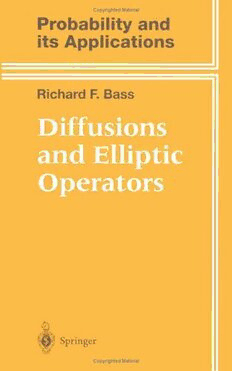Table Of ContentDiffusions and
Elliptic Operators
Richard F. Bass
Springer
To the memory of my father, Jay Bass
(1911–1997)
This page intentionally left blank
PREFACE
Theinterplayofprobabilitytheoryandpartialdifferentialequations
forms a fascinating part of mathematics. Among the subjects it has in-
spired are the martingale problems of Stroock and Varadhan, the Harnack
inequality of Krylov and Safonov, the theory of symmetric diffusion pro-
cesses, and the Malliavin calculus. When I first made an outline for my
previous book Probabilistic Techniques in Analysis, I planned to devote a
chapter to these topics. I soon realized that a single chapter would not do
the subject justice, and the current book is the result.
The first chapter provides the probabilistic machine needed to drive
thesubject,namely,stochasticdifferentialequations.Weconsiderexistence,
uniqueness, and smoothness of solutions and stochastic differential equa-
tions with reflection.
The second chapter is the heart of the subject. We show how many
partial differential equations can be solved by simple probabilistic expres-
sions. The Dirichlet problem, the Cauchy problem, the Neumann problem,
theobliquederivativeproblem,Poisson’sequation,andSchro¨dinger’sequa-
tion all have solutions that are given by appropriate probabilistic expres-
sions. Green functions and fundamental solutions also have simple proba-
bilistic representations.
Ifanoperatorhassmoothcoefficients,thenequationswiththeseop-
erators will have smooth solutions. This theory is discussed in Chapter III.
The chapter is largely analytic, but probability allows some simplification
in the arguments.
ChapterIVconsidersone-dimensionaldiffusionsandthecorrespond-
ingsecond-orderordinarydifferentialequations.Everyone-dimensionaldif-
viii PREFACE
fusion can be derived from Brownian motion by changes of time and scale.
Whatiscoveredinthefirstfourchaptersismostlyclassicalandwell
known. The next four chapters discuss material that has appeared only in
much more specialized places.
Chapter V concerns operators in nondivergence form. After some
preliminaries,thediscussionturnstotheHarnackinequalityofKrylovand
Safonov and then to approximating operators with nonsmooth coefficients
by those with smooth coefficients. Even in the nonsmooth case, solutions
to these equations will have at least some regularity.
ChapterVIconcernstheexistenceanduniquenessofthemartingale
problem for operators in nondivergence form. If the coefficients are contin-
uous, there exists only one process corresponding to a given operator. A
similar assertion can be made in certain other cases.
In Chapter VII we turn to divergence form operators. Our main
goalsaretoderiveMoser’sHarnackinequality,upperandlowerboundsfor
the heat kernel, and path properties of the associated processes.
Finally,inChapterVIIIweconsidertwodifferentapproachestothe
Malliavin calculus. We show how each one can be used to prove a version
of H¨ormander’s theorem.
Inthisbookweconsideronlylinearsecond-orderellipticandparabol-
icoperators.Thisisnottoimplythatprobabilityhasnothingtosayabout
nonlinear or higher-order equations, but these topics are not discussed in
this book.
Itisassumedthatthereaderknowssomeprobabilitytheory;thefirst
chapter of Bass [1] (referenced in this book by “PTA”) is more than suffi-
cient. References are given for the theorems from probability and analysis
that are required.
Each chapter ends with some notes that describe where I obtained
the material and suggestions for further reading. These are not meant to
be a history of the subject and are totally inadequate for that purpose.
Most of the material covered has previously been the subject of
courses I have given at the University of Washington, and I would like to
thank the students who attended and pointed out errors. In addition, I
would like to give special thanks to Heber Farnsworth and Davar Khosh-
nevisan, who read through the text and made valuable suggestions. Partial
support for this project has been provided by the National Science Foun-
dation.
Some notation
We will let B(x,r) denote the open ball in Rd with center x and
radius r. We use | · | for the Euclidean norm of points of Rd, for the norm
of vectors, and for the norm of matrices.(cid:1)To be more precise, let ei denote
theunitvectorinthexi direction.Ifv = di=1biei andAisamatrix,then
Some notation ix
(cid:2)(cid:3)d (cid:4)
1/2
|v|= b2 , |A|= sup |Av|.
i
i=1 |v|=1
The inner product in Rd of x and y will be written x·y. If A is a matrix,
then AT denotes the transpose of a. Kronecker’s delta δij is 1 if i=j and
0 otherwise. The complement of a set B is denoted Bc.
∂t is an abbreviation for ∂/∂t and ∂i an abbreviation for ∂/∂xi.
The Lp norm of a function f will be denoted (cid:1)f(cid:1)p. We define the Fourier
transform of a function f by
(cid:6)
f(cid:5)(ξ)= eiξ·xf(x)dx.
Rd
A smooth function is one such that the function and its partial derivatives
of all orders are continuous and bounded. The notation 1A represents the
function or random variable that takes the value 1 on the set A and 0 on
the complement of A.
If Xt is a stochastic process and A a Borel subset of Rd, we write
TA =T(A)=inf{t>0:Xt ∈A}
and
τA =τ(A)=inf{t>0:Xt ∈/ A}
for the first hitting time and first exit time of A, respectively.
The letter c with a subscript indicates a constant whose exact value
is unimportant. We renumber in each theorem, lemma, proposition, and
corollary.
The reference PTA refers to Bass [1].
Seattle, Washington Richard F. Bass

